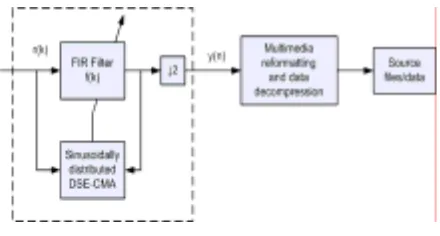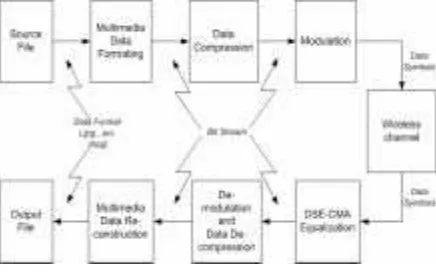Adaptive Blind Channel Equalization for Mobile Multimedia Communication
Jusak Irawan
Sekolah Tinggi Manajemen Informatika & Teknik Komputer (STIKOM)Surabaya Jl. Kedung Baruk 98, Surabaya 60298
Abstract
In the last decade much research effort has been dedicated to deal with the issues of wireless multimedia communications, in particular bandwidth limitation and channel impairment. We have recently proposed a new scheme for blind equalization called sinusoidally-distributed dither signed-error constant modulus algorithm (S-DSE-CMA). In this paper, we test this scheme for wireless image transmission. Simulation showed that the low complexity of implementation and fast convergence rate are the major advantages of employing the new scheme for multimedia applications. It is also shown, from perceptual-based analysis as well as objective measurements using peak signal-to-noise ratio (PSNR) of the recovered image, that the recently-proposed blind adaptive equalization algorithm outperforms existing methods, e.g., uniformly-distributed DSE-CMA.
Keywords: equalization, inter-symbol interference, constant modulus algorithm, multimedia.
Abstrak
Dalam beberapa tahun terakhir, usaha-usaha penelitian dilakukan untuk menyelesaikan permasalahan-permasalahan yang ada pada bidang multimedia untuk komunikasi nirkabel. Permasalahan-permasalahan tersebut misalnya keterbatasan lebar jalur dan distorsi kanal komunikasi. Dalam paper ini, sebuah algoritma baru dibuat untuk ekualisasi secara buta terhadap kanal komunikasi nirkabel. Algoritma tersebut disebut sebagai sinusoidally-distributed dither signed-error constant modulus algorithm (S-DSE-CMA). Pengujian dilakukan dengan mengirimkan informasi dalam bentuk gambar yang ditransmisikan pada kanal komunikasi nirkabel. Dari pengujian didapatkan bahwa dengan menggunakan algoritma baru ini terdapat dua kelebihan dibandingkan algoritma yang telah ada (uniformly-distributed DSE-CMA) yaitu: kompleksitas algoritma lebih rendah dan kecepatan konvergensi dari algoritma ini lebih tinggi.
Kata kunci: Ekualisasi, interferensi antar simbol, algoritma constant modulus, multimedia.
Introduction
Over the past decade, the demand for multimedia applications and services over wireless networks such as 3G mobile communication systems has grown considerably. Reported studies into next-generation (NG) wireless mobile networks [1] have shown a significant trend towards personalized mobile com-munications-ubiquitous computing-and a stronger need for wireless multimedia-equipped devices. This has stimulated a significant increase in the amount of wireless data transmitted due to multimedia content, causing a major shift from traditional wired telephony-oriented services, which have predomi-nantly supported the transmission of voice data.
The processing of digital video, images, and audio signals using sophisticated and quite complex algorithms (codecs) are at the heart of many modern communication products, from personal digital assistants (PDAs) to video-capable cell phones.
Note: Discussion is expected before December, 1st 2006. The
proper discussion will be published in Electrical Engineering Journal volume 7, number 1, March 2007.
Understanding the characteristics of wireless digital communication systems designed for the transmission of multimedia signals is essential for developers of the systems that target multimedia applications.
One of the main issues with mobile multimedia communication, however, is the degradation in both communication channel performance, system latency, and acceptable quality of multimedia data received on wireless terminals devices. This is mainly due to the inherent characteristics of wireless communication systems – the time-varying nature of wireless channel conditions and propagation environments [2].
The communication bandwidth available to wireless mobile systems for the transmission of multimedia data, and the processing capabilities of the commu-nication system/devices, are often severely limited. Mobile radio channels must, therefore, transmit user information in a highly compressed form, while making efficient use of available frequency spectrum and communication power.
As a result, new ways of 'adaptively' compressing, modulating, encoding and transmitting multimedia data (by dynamically controlling communication parameters to suit variations in channel conditions, computational requirements, and available processing resources) have emerged [5], [6], [7], [8]. Further-more, due to the demand for high data rate transmission of multimedia signals over video-capable wireless networks, channel equalization has become essential in dealing with the problems associated with inter-symbol interference (ISI). On the other hand, space-time coding (STC) and orthogonal frequency division multiplexing (OFDM) have emerged as powerful techniques to minimize the system bit error rate, and hence opened the way towards increasing data rates to support multimedia applications as we have shown in [9].
Blind equalization has been extensively used in communication systems to remove the ISI produced by dispersive channels [10], and has become increasingly important where full bandwidth utilization of the channel is necessary. It is well known that conventional equalization techniques rely on the transmission of training signals which leads to a reduction in channel bandwidth and allocated resources. The main advantage of using a 'blind' system is apparent where the use of training signals is both unrealistic and costly to implement.
The Constant Modulus Algorithm (CMA) that was originally proposed in [11], has attracted the main research effort as a suitable blind wireless channel equalizer; due to its robustness over the violation of perfect blind equalization (PBE) conditions [12]. To achieve the low complexity requirement of the CMA algorithm, recent studies associated with the fractionally-spaced equalization constant modulus (FSE-CM) algorithm have lead to the development of the dithered signed-error constant modulus algorithm (DSE-CMA) [13]. In this scheme, the input signal to the equalizer is dithered by a non-subtractive sinusoidally-distributed signal before a sign operation is applied.
In this paper, we investigate the characteristics and system performance of a wireless multimedia communication system using the DSE-CMA blind equalization technique in the application of
compressed images. The framework developed can be extended to study the transmission of other types of multimedia signals such as, high rate digital video. Empirical results obtained are used to determine subjective (perceptual-based) quality issues, without the need for an extensive numerical analysis; as is often required in most research studies.
System Model
Figure 2. Transmitter block for T/2 baseband
com-munication system
Fig. 1 and Fig. 2 depict a multirate model of a baseband communication system comprising of a
transmitter and receiver part, where subscript n
denotes baud-spaced quantities and subscript k
represents T/2 fractionally-spaced quantities. Through
this system, a sequence of formatted multimedia data
symbolized as xn with T symbol period is transmitted
through the T/2-spaced channel c of a length Nc. In
many communication systems, even in the absence of noise the effects of filtering and channel-induced distortion lead to inter-symbol interference (ISI). Therefore, in addition to the white Gaussian noise the received signal is also corrupted by ISI. These distorted signals can only be removed by employing an equalizer in the receiver. Following the figures, the system output of the equalization may be expressed as:
Figure 1. Receiver block with a linear equalizer for
T/2 baseband communication system
( ) ( )
( ) ( )
length source symbol vector of a length
(
)
+ −1/2
= c f
x N N
N , while f is representing a
and w(n) be the symbol of time-decimated of Nf
received samples and white Gaussian noise,
respectively. A Hermitian operator is denoted by (.)H,
and matrix transposition is symbolized by (.)2. The
matrix c symbolizes a Nxx Nf time-decimated channel
convolution, defined as follows:
A Blind Adaptive Algorithm
Most of blind adaptive equalizers update their coeffi-cient vectors utilizing the stochastic gradient descent minimization method, which has also been used in this paper. The equalizer coefficients are updated according to the following algorithm:
(
n
1
) ( )
f
n
µ
r
( )
n
ψ
cma( )
y
n,
f
+
=
+
(3)where µ is a small constant called the step-size, and
ψcma (yn) is the CMA error function.
A complex-valued error function of CMA is described in [11] as:
( )
*(
2)
,
The objective that the equalizer minimizes the CM cost function (under a perfect blind equalization (PBE) condition [12]) is to remove all the linear distortion incurred by the channel such that the the output of the original source symbols are recovered
for some system delay δ
(
0≤δ ≤Nx−1)
and phaseshift
θ
(
θ
∈[
0,2π
]
)
. Hence, the filter output for perfect equalization becomesδ
Recently, advanced study of blind equalizers moved towards the achievement of complexity reduction. Primarily it is motivated by low cost implementation of the blind systems. One of the methods is transforming the error function in eq. (4) into a sign function. As it can be seen clearly, the multiplication of every regressor element with the error function becomes a multiplication with +1 and -1 only. However, in order to preserve information lost in the quantization process, a small perturbation random signal is added; this is called dithering [14]. Thus the
error function in eq. (4) for complex-valued case is modified to:
( )
(
( )
( )
)
where α is a dither amplitude selected large enough
to satisfy
{
( )
i( )
n}
n are real-valued i.i.d process
sinusoidally-distributed in
(
−α,α)
[13], where the superscripts rand i refer to the real and imaginary components,
respectively.
Modelling of Multimedia Data
To enable the simulation of multimedia data over the multirate communication model, a process for converting multimedia signals from various data sources (such as, compressed audio, image, video files), which may be stored on a PC, has been developed. This has been integrated together with the DSE-CMA blind equalization scheme, to form the overall multimedia communication framework. Fig. 3 depicts the general structure of the conversion process.
Figure 3. Framework for wireless multimedia com-munication using DSE-CMA
The principal idea behind the multimedia data model developed is to first consider the source file (digitized
version of the original multimedia signal with N -bit
resolution) as a vector array containing integer quantization levels. For digital audio, these corres-pond to sampled amplitude values, and for digital image and video coding they correspond directly to pixel values [16]. Before the multimedia data can be processed by the multirate communication model, the source data is converted into a matrix array containing
N bit-words which correspond to the sample pixel
Our research framework includes the simulation of a 'data compression' block for system development along with investigating new adaptive compression algorithms. A channel encoder to convert the bitstream to the required baseband modulated data symbols as specified by the multirate model has been implemented. In the receiver path, the reverse is performed on the modified data symbols produced by the DSE-CMA equalizer. Whereby, the data symbols are first converted back to a bitstream by the channel decoder, and are subsequently reconstructed (via the de-compressor) to the original multimedia data format applied to the system.
To evaluate the performance of the DSE-CMA equalization algorithm in the application of multime-dia data, a test image is transmitted over various wireless communication channels, modelled using the geometrically-based hyperbolically distributed scatte-rers (GBHDS) channel [18]. Two kind of channels simulated urban environments are used, where
Channel A generated with a path lost exponent p =
2.8 and Channel B generated with a path lost
exponent p = 4. The frequency and phase responses of
the channels are depicted in Fig. 4. It can be seen clearly that the channels are frequency selective fading channel with a very deep null produced by Channel A. Such kind of channels obviously give rise to the inter-symbol interference, which deteriorated the received signal significantly.
0 1 2 3
Frequency (radian/s), p = 2.8
M
Frequency (radian/s), p = 2.8
P
Frequency (radian/s), p = 4
M
Frequency (radian/s), p = 4
P
Figure 4. Frequency responses of Channel A and
Channel B with path loss exponent p =2.8
and p = 4, respectively.
A standard version of the 512 x 512 size gray scale
Lena image with 8 bits/pixel resolution1 was used as
the multimedia source data. However, due to practical computational limitations, the image was resized to
1
located at http://www.dsp.ece.rice.edu/wakin/images/lena512
128 x 128 using 'bilinear' interpolation. The re-sized Lena image used for transmission is shown in Fig. 5. The overall communication framework was confi-gured for QPSK baseband modulation. The remain-ning parameters of the fractionally-spaced equalizer
were set as follows: Nf = 16 and α = 1. The dither
amplitude α was set to be large enough to guarantee
the existence of the zero-forcing solutions of the equalizers.
Figure 5. Lena image source file (8-bit gray scale) after resizing to 128 x 128.
Fig. 6 shows the recovered image from the output of
the channel with p = 2.8 where there was no an
equalizer at the input of the receiver. It simulated with SNR = 50 dB. As expected, this results an image which is severely distorted (saturated by noise). Through visual inspection we can confirm that even in the absence of noise, channel-induced distortion leads to ISI, and corruption of the original image.
In order to determine the effectiveness of the proposed DSE-CMA technique the multirate model was configured and simulated for SNR = 20 dB over
a GBHDS channel (p = 2.8), and using a blind
adaptive equalizer based on two schemes. In the first scheme, we used the uniformly-distributed dithered signed-error CMA, and in the second one we employed our proposed sinusoidally-distributed dithered signed-error CMA algorithm. Fig. 7 and Fig. 8 depict the significant improvement of using sinusoidally-distributed DSE-CMA algorithm as compared to the uniformly-distributed DSE-CMA method. This is due to the faster convergence rate of sinusoidally-distributed DSE-CMA as compared to the uniformaly-distributed DSE-CMA [17].
Clearly, for different channel the results obtained are similar. Fig. 9 and Fig. 10 show the equalized images recovered after employing the two algorithms,
simulated over the GBHDS channel p = 4. Under the
20 40 60 80 100120
Figure 6. Received Lena image file (8-bit gray scale) after passing it through the GBHDS channel
p = 2.8 without employing an equalizer,
SNR = 50 dB.
Figure 7. Equalized Lena image file after passing it
through the GBHDS channel p = 2.8, SNR
= 20 dB with blind adaptive equalization utilizing sinusoidally-distributed DSE-CMA.
Figure 8. Equalized Lena image file after passing it
through the GBHDS channel p = 2.8, SNR
= 20 dB with blind adaptive equalization utilizing uniformly-distributed DSE-CMA.
20 40 60 80 100120
Figure 9. Equalized Lena image file after passing it
through the GBHDS channel p = 4, SNR =
20 dB with blind adaptive equalization utilizing sinusoidally- distributed DSE-CMA.
Figure 10. Equalized Lena image file after passing it
through the GBHDS channel p = 4, SNR
= 20 dB with blind adaptive equalization utilizing uniformly-distributed DSE-CMA.
Further analysis was performed using an objective performance metric such as, the peak signal-to-noise ratio (PSNR), commonly used in image processing literature [3]. The PSNR performance curves of the received images transmitted over various wireless GBHDS channels using the two blind equalization schemes, are plotted against different values of SNR. Each value of the PSNR for certain SNR was averaged over 100 realizations. It can be seen in Fig. 12, that the sinusoidally-distributed DSE-CMA algorithm outperforms the uniformly-distributed DSE-CMA algorithm in both cases.
20 40 60 80 100120
Figure 11. Equalized Lena image file after passing it
through the GBHDS channel p = 4, SNR
= 5 dB with blind adaptive equalization utilizing sinusoidally-distributed DSE-CMA.
Conclusion
In this paper, we presented a multimedia communi-cation framework to investigate the characteristics of DSE-CMA blind equalization in the transmission of compressed images over wireless communication channels. Simulation results (based on both user-perceived quality and the PSNR performance metric) showed that the sinusoidally-distributed DSE-CMA algorithm outperforms the existing blind equalization technique (the uniformly-distributed DSE-CMA).
Reference
[1] J. F. Huber, ”Mobile next-generation networks,”
IEEE Multimedia, vol. 11, pp. 72-83, Jan. 2004.
[2] T. S. Rappaport, Wireless Communications
Principles and Practice, 2ed, Pearson Education Inc., Delhi, India, 2002.
[3] M. Ghanbari, Standard Codecs: Image
Com-pression to Advanced Video Coding, The Institution of Electrical Engineers, IEE Telecom-munications Series 49, Herts, UK, 2003.
[4] S. Catreux, V. Erceg, D. Gesbert, and R. W., Jr. Heath, “Adaptive modulation and MIMO coding
for broadband wireless data networks," IEEE
Commun. Magazine, v. 40, pp. 108-115, Jun 2002.
[5] C. N. Taylor and S. Dey, “Adaptive image com-pression for wireless multimedia
communica-tion,'' IEEE ICC, pp. 1925-1929, 2001.
[6] J. Yang, M. H. Lee, M. Jiang, and J. Y. Park, ”Robust wireless image transmission based on
turbo-coded OFDM," IEEE Trans. Consumer
Elec., v. 48, no. 3, pp. 724-730, Aug. 2002.
[7] J. Hagenauer and T. Stockhammer, ”Channel coding and transmission aspects for wireless
multimedia,'' Proc. IEEE, v. 3, pp. 1764-1777,
Oct. 1999.
[8] Q. Liu, S. Zhou, and G. B. Giannakis, ”Cross-Layer combining of adaptive Modulation and coding with truncated ARQ over wireless links,''
IEEE Trans. Wireless Commun., v. 87, pp. 1746-1755, Sep. 2004.
[9] T. Athanasiadis, K. H. Lin, and Z. M. Hussain, “Space-time OFDM with Adaptive Beamfor-ming for Wireless Multimedia Applications,”
Proc. IEEE International Conference on Infor-mation Technology and Applications (ICITA 2005), Sydney, Jul. 2004.
[10] J.G. Proakis, Digital Communications, 3ed,
Mc-Graw Hill International, New York, USA, 1995. [11] D. Godard, ”Self-recovering equalization and
carrier tracking in two dimensional data
com-munication systems,” IEEE Trans. Commun., v.
28, pp. 1867-1875, 1980.
[12] C.R. Johnson, Jr., P. Schniter, T.J. Endres, J.D. Behm, D.R. Brown, and R.A. Casas, “Blind equalization using the constant modulus
criterion: A review,” Proc. IEEE, v. 86, no. 10,
pp. 1927-1950, Oct. 1998.
[13] J. Jusak and Z. M. Hussain, “Evaluation of a sinusoidally-distributed dithering for signed-error constant modulus algorithm: performance comparison with uniformly-distributed
dithe-ring,” Proc. The 3rd Workshop on the Internet,
Telecommunications and Signal Processing (WITSP), Adelaide, Australia, Dec. 2004.
[14] P. Schniter and R. J. Johnson, Jr., “Dithered signed-error CMA: the complex-valued case,”
Proc. 32nd Asilomar Conf. on Signals, Systems, and Computers, pp. 1143-1147, 1998.
[15] P. Schniter and R.J. Johnson, Jr., “Dithered signed-error: robust, computationally efficient
blind adaptive equalization,” IEEE Trans. Signal
Processing, v. 47, no. 6, pp. 1592-1603, 1999.
[16] Kr. Mandal, Multimedia Signals and Systems,
Kluwer Academic, Massachusetts, USA, 2003. [17] J. Jusak and Z. M. Hussain, “Performance of
sinusoidally-distributed dithering for
signed-error constant modulus algorithm,” Proc. IEEE
International Conference on Information Tech-nology and Applications (ICITA 2005), Sydney, Australia, Jul. 2005.
[18] S. S. Mahmoud, Z. M. Hussain and P. O'Shea, “A space-time model for mobile radio channel
with hyperbolically distributed scatterers,” IEEE



